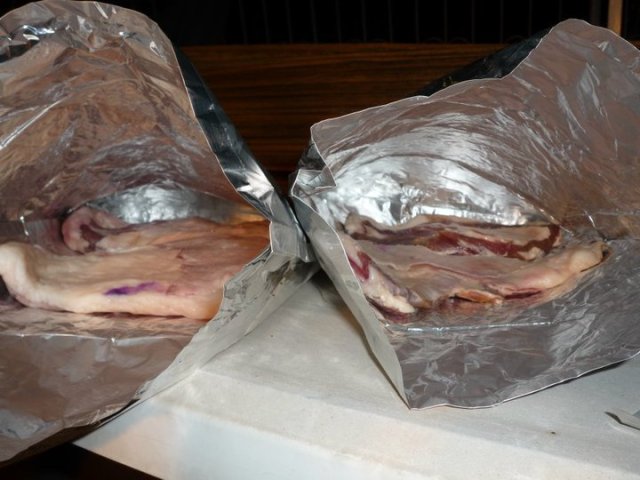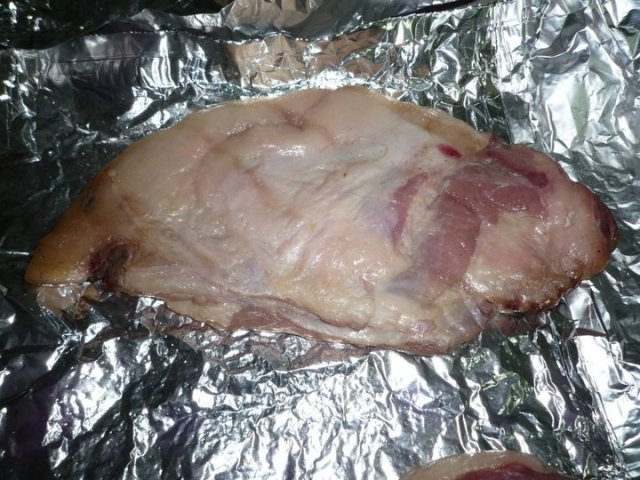I have a number of food memories that are all tied to pork. When we lived in Orange County, my dad and I would spend Sunday mornings at Paul’s Coffee Shop . I always got the biscuits and gravy with a chocolate milk and Dad would get (and will get until this day) chicken fried steak, eggs over easy, hashbrowns (crisp) and sourdough toast. For a couple holiday seasons, we would get a spiral cut honey baked ham–the crunchy, sweet skin residue was too irresistible to pick off itself. In numerous Asian food malls around Southern California, my mother would get me my favorite chao siu bao–perfectly white, slightly sweet yeast buns with a savory, sweet, and sticky mess of barbeque pork stuffed right into the middle. Thanks Mom and Dad.
Yet, my most delicious pork memory may be the time we stayed at the Embassy Suites when first visiting North Carolina before moving. The buffet there is an incredible thing, complete with an omelette guy, but nothing stands out more than the massive silver chaffing dish filled to the brim with hot bacon. In my mind, it looks like a treasure chest of delicious. This post is dedicated to that chaffing dish, wherever she is now.
When last we met, the bellies were taking a week long break in the refrigerator. During that time, Josh flipped and rubbed them to make sure the cure was working its magic evenly. All the literature says that a lot of moisture is supposed to expel from the meat during that time. This did not happen for us, but we went ahead anyway. A week later, I took the bellies out for their next step.
Step #3: Soaking
This may be the least glamorous step in this entire process. Why, you might ask? Because all I did was set the bellies in a cool filtered water bath for an hour to allow any of the excess salt to leech out of the meat. It was so uninspiring, I didn’t even take a picture, but it probably looked something like this.

So...many...bellies...
The meat sat in the fridge for an hour and a half, but this was only guess work. I have read several blogs where aspirin chartuiers complain about how salty their bacon turned out and realize they should have soaked it for longer. After the stint in the fridge, I actually cut off two slices from each belly to test the salinity. It tasted like salty lamb, not too salty, but not yet bacon. Bellies aren’t bacon until they have been smoked.
The half step is actually a very important one. After patting the meat dry, I returned it to the fridge for twelve hours to dry even further. During that time, the bellies develop what is called a pellicle. During Step #2, the cure was busy drawing water soluble proteins to the surface of the meat. While drying, the proteins create a pellicle, a membrane of sorts which allows the smoke vapor and colloids to adhere to the meat, helps seal in the remaining moisture through the smoking process, and prevents the fat in the meat from rising to the surface and spoiling. If you don’t have a pellicle, you don’t have bacon.
Step #4: Smoking
If I may speak personally, this was the step I was most looking forward to. My steady summer diet of food television, from everything to “BBQ Pitmasters” to watching this this guy eating buckets of barbeque made me voraciously eager to eat something that was cooked ‘low and slow’. Smoking seems to be in my blood, as well. Mom has regaled me with stories of a little electric smoker she got as a wedding present, using it almost weekly (she even thought to bribe me with this if I came back from Israel).
Not having much of a clue as to what we were doing, Josh bought a few smoker bags and brought them to Jerusalem. Owning a full blown, stand-up smoker and wood chips would always be ideal, but in their absence, this would have to do. The idea behind this contraption is to wrap the food in a large aluminum bag with two layers. Between the two layers of aluminum foil lies alder wood dust, which when heated to a temperature of 140°F, releases smoke throughout the bag. Without a smoker, Josh called upon our buddies Jason and Dara to use their American style grill.
I placed the bellies in the bag and wrapped them according to the directions. Their was no potent smell to the bags, and at this point, I was worried that the smoking process would be further out of my control then I would have liked. For starters, a gas grill, even on its lowest setting, can get to around 200°F, sixty degrees higher than the ideal temperature for smoking bacon. My other concern was the technology at hand: what the hell were these bags and how were they going to affect the taste and smell of the meat we had tended to all week? What does Alder wood taste like?
Most of my fears started to come true the minute I put the bags on the grill. The heat went up way too high, much to quickly, potentially ending this entire project. The temperature at which lamb actually begins to cook is approximately 325° F…with the cover down, the grill was way on its way to 300°F.
For a quick fix, I put the lamb on the opposite side of the grill away from the flame, and propped open the lid to keep it below 200°F. Remember, the smoking process takes at least one hour for the smoke to be imparted to the meat. If you cross over into cooking range, the pellicle will dry out and the smoke will not be able to penetrate the meat and fat. They call it ‘cold-smoking’ for a reason.
After an hour of beer drinking and haphazard sukkah construction, the bellies were ready to be taken off the fire. I eagerly unwrapped the each bag, huffing into the aluminum bag like a hobo into a sock filled with paint. The smell was there! I removed the bellies to reveal a changed thing, something that had gone through a molecular transformation. The color, the texture–it was no longer cured meat. It was…BACON.
And that was it. After a week of guessing and hoping, it lay there before me. Less glorious then that silver treasure chest of bacon at the Embassy, but it was made by our own hands.
But how would it hold it up in the pan?







After curing, do the bellies have to be smoked, or can I just skip ahead to frying?
And if it does really need to be smoked, can I slap one a dem Alder Smoker Baggies in an oven?
And are ya’ll sellin?
The bellies MUST be smoked, otherwise, it is not technically bacon. You could try to play around with an oven, but I can’t comment since I haven’t tried it. You don’t have access to a grill?
And yes, we are selling. Contact me at tzachi0@gmail.com to talk.
We need to talk about how to set up a proper smoking pit so you can do this easier.
Next time you can add some smoke liquid to the cure solution instead